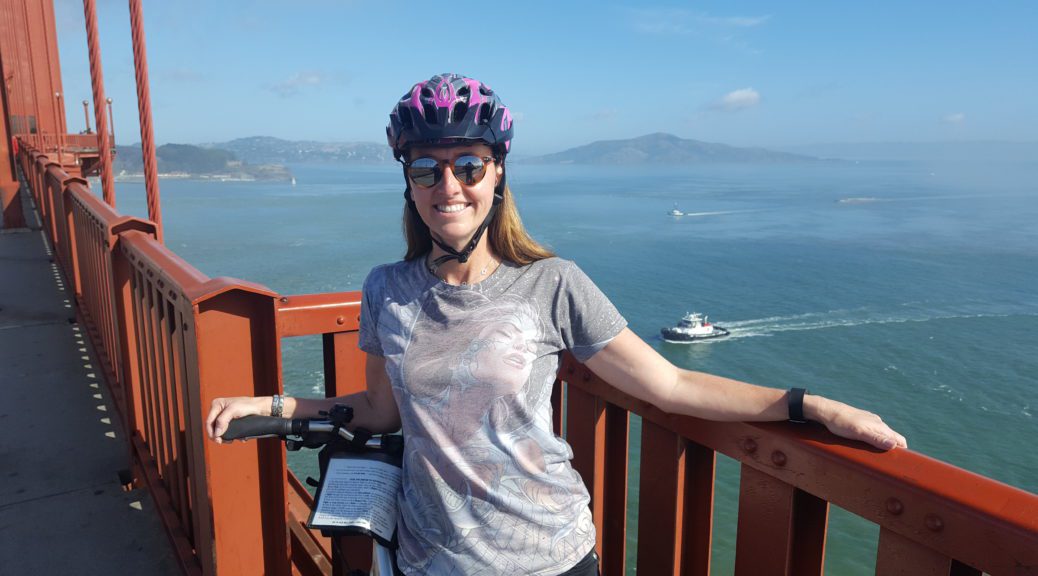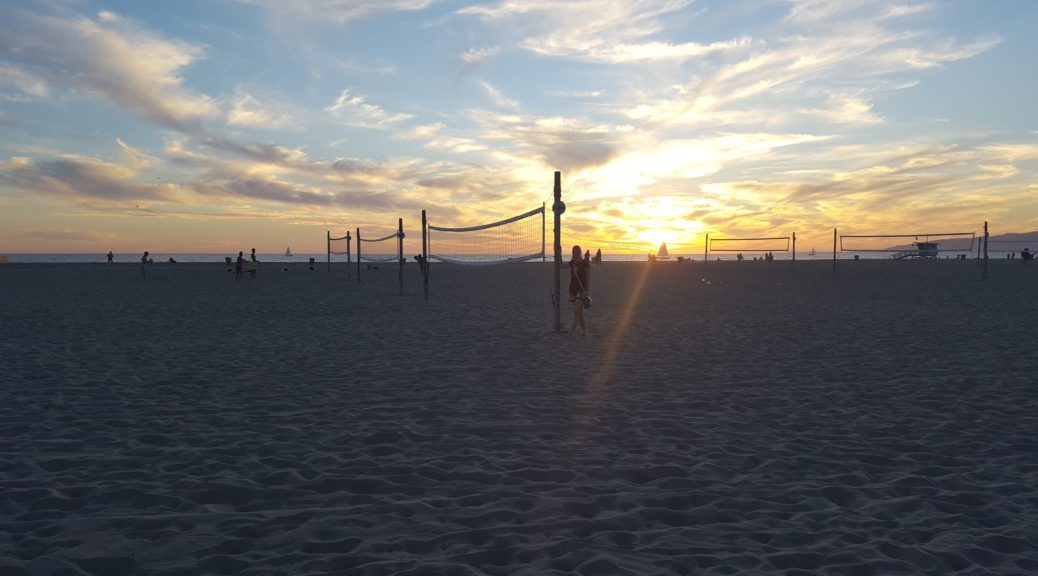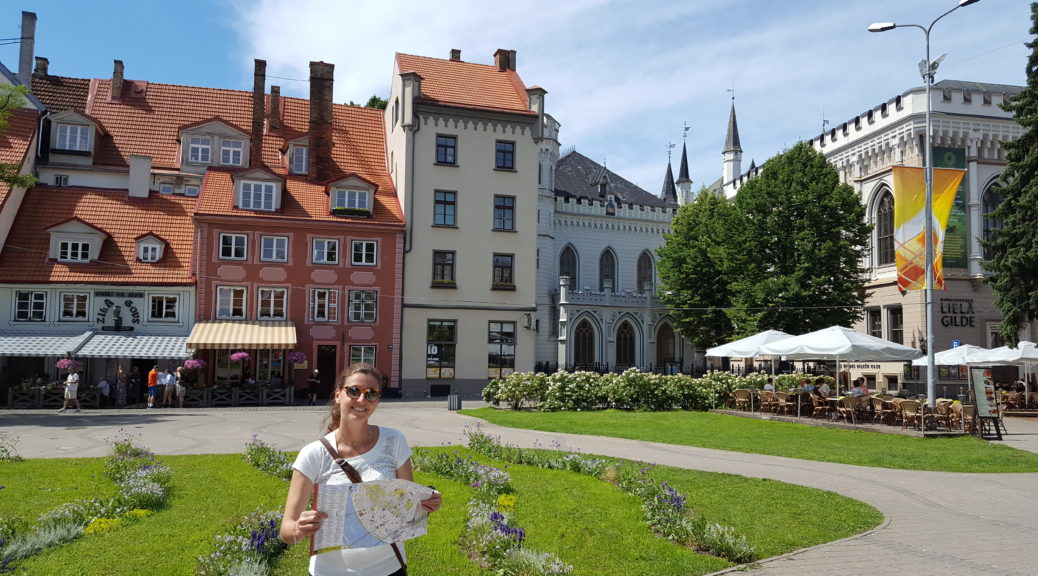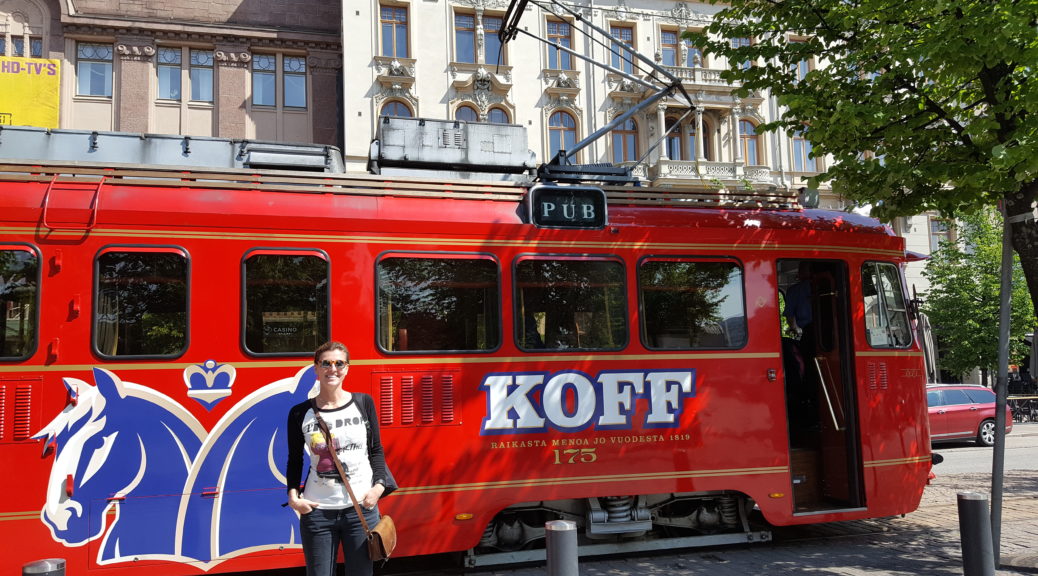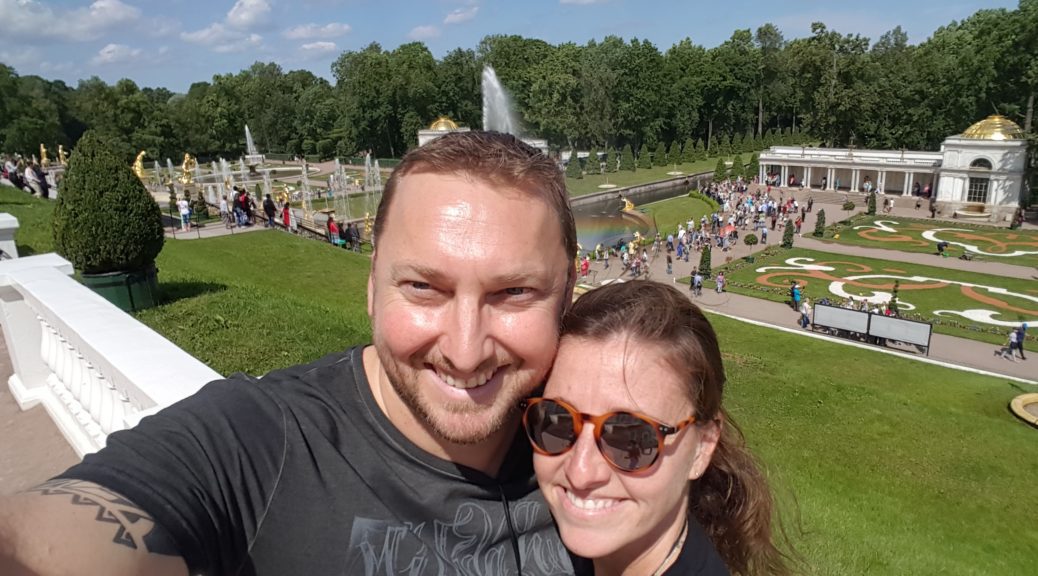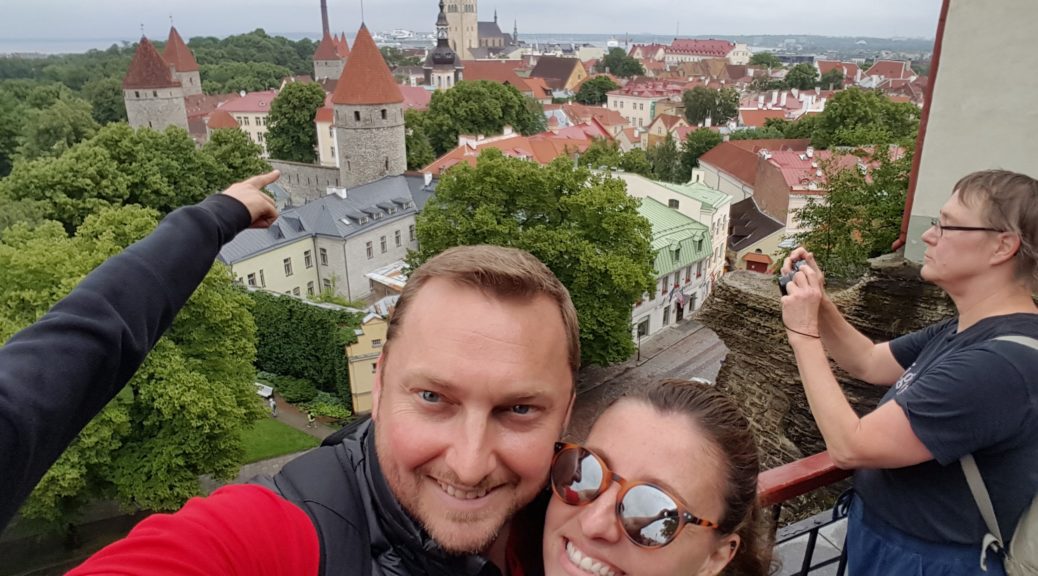SAN FRANCISCO
15 – 19 October 2016
After a whirlwind Las Vegas visit, we had a relatively relaxed morning to get ourselves in order and to the airport for a 13h05 flight to San Francisco, which was a relief seeing as we had to make a detour past the Southwest Airline offices to get a replacement suitcase for my Cellini they’d damaged on the flight from LA.
The Lyft driver laughed out loud when he saw the state of my luggage. Completely zipless, we’d resorted to keeping it closed with tape wound around and around. I bet he thought we’d gambled away our fortunes and were leaving as paupers.
We got dropped off at the Arrivals Terminal that was home to the Southwest office and were relieved when the clerk simply brought out a new case for approval for a straight swap. With little choice, we cut open the old-new case and packed everything into the new-new case. I was sorry to see my fancy almost-new case go… but very relieved to have a zipable replacement! That came with its own lock!
With plenty of time to spare, we made our way over to the Departures Terminal… only to find our plane was delayed by an hour. Sigh. We made our way to Carl’s Jr and tried to make a slow experience out of the fast food to kill time.
The wait was longer than the flight. Thankfully. The delay had been thanks to bad weather on the San Francisco side, so it was a bit of a bumpy ride in places.
But we did get there in one piece (each, although my brand new lock had been ripped off – but zip intact this time – somewhere somehow in transit) and were soon in a Lyft ride into town, having evaluated that it was about the same price as public transport, but a door-to-door and a third of the travel time.
We checked into the Pacific Motor Lodge, which is a fading remnant of a motel that might’ve been quite something in its heyday (in the 60s!). Hard to believe that place was almost twice the price of georgeous Harrahs in Vegas!
Our room was more of a suite with king size bed, large credenza and desk, full lounge suite, full kitchenette and a little dressing room leading into the bathroom. Based on the wallpaper and the phone socket in the loo, this set-up was more legacy than opulence.
The tourist map told us what we’d hoped. Our hotel, in North Beach, very conveniently epicentred everything we planned to see and do, so we decided to satellite to Union Square since that was in the opposite direction to what we had planned for the next couple of days.
Sadly, it had started to drizzle as we left the hotel.
Our walk took us along Stockton through Chinatown and it was a mission to negotiate the vendors whose wares displays (mostly fruit and veg) spilled onto the pavement, and their customers, and people with brollies, along with our own intention of making the most of the many awnings overhead to save us from the rain.
We’d about run out of patience with the game when we emerged from Chinatown right into the upmarket shopping district around Union Square.
It was a bit of an anticlimax to get to Union Square, which held little interest bar a tall column statute (that we were not even keen to photograph in the poor dusk light and the unfavourable conditions), so we sought solace in the doorway of the iStore and used their free wifi to scan Trip Advisor for something in the area worth doing.
It turned up Happy Hour at Bar 587; the name referring to its address on Post Street (the road we were standing on).
We nipped up the street and were rewarded our efforts with 2 open stools, as we walked in, against the bar. What a pleasure to be warm and dry. And to have $5 beers to celebrate with!
The bartender was very helpful and guided us through the regular offerings, the specials and his recommendations – all verbally, saying he’d dispensed with the menu system since it changed too often.
It was amazing to watch him in action. He did the job that would take 3 or 4 people at home. He negotiated orders – with questions, consideration and detailed suggestion; prepared the drinks – which were often complicated cocktails; served drinks and food; cleared and loaded a dishwasher below the counter and restocked his glasses.
We also marvelled that he tested every cocktail. He took a clean straw, nipped a sip of the cocktail into it and tasted, adjusting the final product if required. He must be hammered by the end of the night!
Not that we were there to see it. Having entertained ourselves for a couple of hours, discussing “the game” (American football) with our neighbours at the bar counter, the rain had abated and went on the hunt for a good Chinese dinner in our home turf, prioritising a place called “Capital” that was recommended by Trip Advisor.
We found it with no trouble – and 15 minutes to spare before the kitchen closed. The waitress recommended the set menu and we couldn’t argue; it had a bit of everything: dimsum soup, spring roll, sweet & sour chicken, broccoli beef, fortune cookie, Oolong tea. Everything fresh and crisp.
Perfect dinner with a short trot home afterwards to shift everything.
SUNDAY
We’d pre-booked our Alcatraz Island trip so all that was required on Sunday morning was to get up and walk to the docks to catch the ferry.
The package we had booked included a pre-tour to Angel Island, San Francisco’s version of Ellis Island.
Until about ten thousand years ago, Angel Island was connected to the mainland; it was cut off by the rise in sea levels due to the end of the last ice age. From about two thousand years ago the island was a fishing and hunting site for Coast Miwok Native Americans. The entire island is included within Angel Island State Park and is administered by California State Parks. It has been used for a variety of purposes, including military forts, a US Public Health Service Quarantine Station, and a US Bureau of Immigration inspection and detention facility. The Angel Island Immigration Station on the northeast corner of the island, where officials detained, inspected, and examined approximately one million immigrants, has been designated a National Historic Landmark.
The less romantic side of the story speaks of the Chinese immigrants who were detained on the island for unpredictable lengths of time – often amounting to months – while their connections to the US were confirmed; only foreigners with immediate family already naturalised in the US were considered. The Chinese detained on Angel Island carved poetry into the walls telling of their trials and tribulations, which is still visible today.
All this was told to us on our 1 hour tram tour up and down the island in the pouring rain, with scenery being pointed to us by the recorded audio voice that clearly couldn’t see that we couldn’t see a damn thing through the misted plastic window sheets drawn on either side of the tram that both protected us from the rain and prevented us experiencing the scenery. This however didn’t stop the lady in front of us from snapping away wildly with her camera. Her holiday slideshows must be the worst!
We still had an hour free time “to explore the island at leisure”, which obviously wasn’t going to happen in these circumstances. We crammed into the café at Ayala Cove with everyone else and grabbed a bowl of chilli to try warm up. There were far fewer chairs than people so we gratefully accepted when offered the spare chairs at Wild Photo Snapper’s table. True to form she was still taking pics of who-knows-what until we left.
The ferry was a quick hop to Alcatraz and we were lucky to get a place to sit in the inside cabin to warm up and dry off.
Alcatraz is a National Park and its size (1/33 the size of the 1 square mile Angel Island) and isolation make it easy to see why it was seen to serve well as a fortress, military prison and then Department of Justice maximum-security federal penitentiary.
The tour comes with a free self-guided audio track, which is genius because everyone can start at their own time and move at their own pace, so you don’t have the waiting and bunching that come with popular group tours. The audio is narrated by former Alcatraz prison guards and prisoners for an extra dose of authenticity.
Easily the best audio tour we’ve ever done, the narration guides you through the cell blocks, providing background and anecdotes to bring the cells and their inhabitants to life in your imagination. It sounds like The Rock was a fitting punishment for the hardened criminals it housed, unashamed combining confinement, isolation and monotonous routines to make days and weeks blend into one another. Also, the fact that it was eventually closed (on 21 March 1963) due to deteriorating buildings and high operating costs (eg lack of sewage system) hints that life in the prison may have been even more unimaginably unpleasant than merely being cooped up.
We were fortunate to catch one of the ranger’s doing a talk on Escape Attempts (36 prisoners attempted; all but 5 recaptured or “otherwise accounted for”, ie killed), providing a granular account of events and pointing out the actual cells and bars for authenticity. It was captivating. So easy to imagine the desperation of the prisoners trying to escape and how terrifying it must have been for the guards trying to prevent them from doing so.
Many of the 90 guards lived on the island with their families, in a compound laid out like a very normal-looking suburb and the accounts from the now-elderly then-children speak of it as an idyllic place to grow up. There were lots of kids, who went to school on the mainland everyday by boat and then returned in the afternoon to play ball in their ballpark, laughing in the sunshine. Thankfully, none of those hardened prisoners figured out a way to use these families as a vulnerability or who knows what stories would be told on the tour today!
What is a frightening story is a stat on one of the placards in the Museum that said that 1 in 32 Americans is currently incarcerated, on probation or on parole. And, worse than that, 10% of American children have at least one parent in prison, on probation or on parole. Hectic! … Although if that stat is higher than ours back home, then maybe it should be seen more as good news that their law enforcement is effective and zero tolerance, rather than having offenders on the streets with no opportunity for rehabilitation.
Fortunately it had stopped raining shortly after we got to Alcatraz so we were able to enjoy the grounds (although the majority worth seeing and doing is in the prison building itself).
We caught the 16h15 ferry back to San Francisco, so had made a real day of the Alcatraz tour!
Our dinner plan for the evening was to visit Kennedy’s, an Irish Pub & Curry House. With a combo like that, how could we not?!
We took a very slow amble along the entire waterfront, getting our ducks in a row for the Monday sightseeing as we window-shopped and enjoyed the not-rainingness. There is lots to do and see on Pier 39 and Pier 43 and everything in between so it was easy to entertain ourselves for a couple of hours.
Kennedy’s served a good curry! We had a firm favourite (chicken jalfrezi) and a new-for-me goat (!) served in an onion and black pepper gravy. Both were delicious, but would have been better with a garlic naan rather than the plain ones we’d ordered because we couldn’t justify the extra $1,50 each for garlic! Also a pity they’d just changed the Guinness barrel so it was warm, otherwise we’d have had the perfect pairing.
No mind, we managed to log a pint on our Guinness Index on the way home at a treasure of a pub called LaRocca’s. The owner is the current coach of the Golden Gate Rugby team and Tony Daly the ex-Wallabie player bartended there for 5 years. The pub was very lively (well, loud at least) with locals watching Major League baseball.
Monday morning was far cheerier, with blue skies and no signs of rain. Our agenda was to make use of our GO card, which allowed unlimited activities at GO partners for 2 days.
We started with the most obvious: the Hop On Hop Off bus tour. The card only included the Red Route but when we got to the starting point, there were a few buses lined up and revving to leave and we accidentally jumped on the Blue Route bus.
What a fortuitous mistake. We had an excellent guide, Norm, with a wicked sense of humour and a remarkable knowledge of San Francisco so we spent 2 hours enjoying a narrated circumnavigation of the 7×7 mile peninsular that is San Francisco.
San Francisco according to Norm’s tour:
- San Francisco was a 600 pax fishing village until, in 1849, they found gold and the population turned into tens of thousands virtually overnight.
- On 18 April 1906 an earthquake measuring 7.9 on the Richter scale took out all but 27 buildings in downtown. The resultant 3 day fire did the most damage though and was eventually prevented from moving further west by dynamiting a few rows of houses to create a fire break.
- Trams were invented in 1873 by wire- cable manufacturer Andrew Hallidie when he witnessed an accident in which a horse-drawn carriage faltered and rolled backwards downhill dragging the horses behind it. The cable cars remained the primary mode of transport until the 1906 earthquake, when most were replaced with railway when the city was rebuilt. The remaining cable cars are the only vehicles of their kind still in operation and are thus designated National Landmarks.
- There are more dogs than children in SF.
- Lombard Street separates Cow Hollow from the Marina, which was created by moving all the rubble from the earthquake into a bog. In 1988 the next earthquake damaged this area the most because the rubble wasn’t compacted.
- Lombard Street is also known as “the crookedest street in the world” because it has 8 sharp turns on a 40 degree slope! The switchbacks were built in 1920s to allow traffic to descend the sharp incline and zigzag around pretty flowers with a nice view of the bay. Pavements are replaced with cement staircases because the road is so steep!
- 9 years after the earthquake, San Francisco hosted a World Fair – 20 million people showed up. The only surviving building from this is the Palace of Fine Arts, the shape of which some say was the inspiration for George Lucas creating R2D2.
- Golden Gate Bridge is 1.7 miles long, painted International Orange and named for the body of water it runs over. It is constructed with 88 thousand miles of cable that would go 3 times around the Equator. Before its completion in 1937, it was considered unbuildable because of foggy weather, 60 mile per hour winds and strong ocean currents sweeping through the rugged canyon below. But $37 million and 11 fatalities brought the bridge to fruition and it sways up to 27 feet to withstand the strong winds.
- The Presidio has been an army base longer than America has been a country, ie 1776-1995. There is a 3000 name long waiting list to rent a house in Presidio now. (It looks a bit like the houses in Army Wives; pretty wooden slatted houses with green gardens and a hanging post box at the end of each driveway).
- Golden Gate Park is 3 miles long by half a mile wide. Windmills pump water for the grounds, which includes a model boat lake, a golf course, a few museums etc. John Maclaren created this park against all odds, being told that nothing would grow on the previously arid soil. He collected all the manure he could by offering to collect all the horse excrement the whole town was producing and created the rich soil required for the lush park. He hated statues so planted trees around them to hide them. When the city put up a commemorative statue of him into his park, he hated it so much that he had his gardeners steal it in the middle of the night and buried it in his back yard, where it was only discovered after he died. He retired at 96 years old and died 4 years later.
- It’s free to go up De Young Art Museum tower, which is 9 storeys and provides spectacular views.
- Height Ashbury is the best ‘hippie spotting’ in the city; it is teeming with organic grocers and has zone laws prevent national chains from establishing in the area. There are lots of brightly painted muralled walls and antique stores. The style that started in the 60s rings true in the hybrid mixture of shops, restaurants and residents and there is even still a store that always has and always will only sell tie-dyed stuff!
- Alamo Square has a mix of some 14,000 beautifully preserved – and wallet-shatteringly expensive – old houses in the Queen Anne, Matchstick, Victorian and Edwardian styles. Postcard Row is said to the the most photographed spot in the city, with its colourful Victorian “painted ladies” with the San Francisco skyline in the backdrop. It also smells like oak BBQ from all the restaurants.
- (Norm was very smug that the) City Hall is taller than the one in Washington, since the law says no state capital buildings shall be taller than the nation’s… but Sacramento is the capital of California. The building is also really pretty, roof adorned with genuine 24 carat gold, and can be rented out for private events.
- By stark contrast the Tenderloin, a sliver of seedy suburb in the midst of its opulent neighbours, is the kind of place you automatically clutch your bag tighter during the day and walk the long way around at night. Weirdly, there is an enormous Hilton hotel in the middle of it that takes up an entire city block and wouldn’t be misplaced in Vegas if it had a casino.
- Chinatown’s entrance is marked with dragon-adorned Pagoda Gates on the Grant Avenue entrance, which was a gift from Taiwan. It has a population of over 100,000 people which is 1/5 of San Francisco’s entire population. The average age is about 50 (because all the young people move to suburbs) and the predominant language is Cantonese because the majority of immigrants came from Taiwan and SE China.
- Grant Avenue was the first road in San Francisco and was originally named Dupont.
Our tour had taken us full circle and left us full of new knowledge, so we decided to do some more lowbrow entertainment. Our GO Card was good for inspiration, so we took a walk through Ripley’s Believe It or Not Museum and Madame Tussaud’s Waxworks.
In need of (late) lunch and being in prime position at the Fisherman’s Wharf, we used our GO Cards to get tickets to the 2 Bridge Cruise (which would take a couple of hours to leisurely cruise to Golden Gate Bridge and then circle back to Bay Bridge) and then grabbed a traditional clam chowder in sourdough bread bowl for our trip. Living the life indeed!
Back on the Wharf, we were spoilt for sundowner options. Joe’s Crabshack won our favour, thanks to their $3 draught offer. It was a fine and festive spot and we learned more than we needed to about a total stranger who was sitting opposite us at the bar and talking the ear off her boyfriend’s friends that she’d obviously just been introduced to. They looked a bit trapped so probably needed the $3 beers more than us… and who knows how long the poor things had to stay there for after we left!
Now with a solid footing on the city layout, we’d masterfully chosen a Groupon offer for dinner in North Beach, the heart of the Italian District and our home turf. Minutes later we were at Pantarei sipping on Chianti and waiting on our Lasagne and Carbonara.
It was nice, but we have had better. I am a bit spoilt with the real Italian cooking I get at the office all the time!
Tuesday’s plan was simple but rather ambitious: cycle over the Golden Gate Bridge.
We got our 1-day bike hire from Blazing Saddles off the Wharf and were soon fitted with helmets and receiving our briefing in the dispatch area.
The briefing was a little brief for my liking and as we were walking our bikes down the hill to the Wharf (as one is legally obliged to, not being able to ride on the pavements), I wondered how Angela Lansbury could be so nonchalant in the opening intro to Murder She Wrote, riding along on her bicycle, trrrrringing her bell with not a care in the world when bicycles are, to be frank, terrifying. It’s hard to believe that none of her episodes featured a cyclist being sideswiped into Cabot Cove by a mystery car. Or a careless cyclist causing one of her whodunnits for that matter.
Fortunately our starting point was quite soothing for my restless mind.
Locals use Crissy Field and Marina Green as their front lawn and beach, where acres of grassy areas lead to the yacht harbour with stunning close-up views of the famous suspension bridge. Between the wide open spaces the oodles of people jogging, strolling and yes, cycling (even kids were getting it right), it seemed like as good a time as any to get started.
Ensuring a wide berth between me and anyone else, I hopped on, swaying a bit to get balance. Pedal, pedal, pedal. I was doing it! Not so bad after all.
After a few minutes, my knuckles loosened and I was able to take in some of the view. Just in time for a dastardly uphill to the Bridge.
Fortunately it was short and we were soon zooming (to my mind at least) past the Presidio and onto the pedestrian / cyclist lanes on the Bridge.
The views are spectacular, with San Francisco on the right, Alcatraz dead ahead and the docks on the Sausalito side on the left. There was a bit of obscuring fog (and a fair amount of sweatiness) preventing us from the perfect pictures, but the memories will always be intact nonetheless.
Reaching the other side, we continued over the hill into Sausalito, which is a pretty little town that looks like it belongs in one of those movies where the opening scene is of a heroine who works in a seaside cafe with a warm window-dressing, a glass counter of homely treats and a bell that tinkles when the door opens.
We parked the bikes and took a quick walk-around. One end to the other and back again.
Given a choice of cycling back, catching the ferry back Sausalito or continuing to the next town, we decided to cycle some more and catch the ferry at Tiburon.
We cycled past the world-famous houseboat community and on an easy ride through Bike Route 8 to the ferry. We’d cycled 32km in 2 hours!!
Originally we’d thought to spend our last afternoon on Treasure Island – halfway along the Bay Bridge between San Francisco and Oakland – but after all the exertion of the day’s outdoorsiness, we were quite happy to be back on dry land, so we went home and showered and went into Downtown instead for a bit of a wander.
After some shopping and window-shopping, we grabbed a bite at Murphy’s Pub. The fish ‘n chips and Mac ‘n cheese just disappeared into the chasm all that cycling had created!
Last thing on the agenda was to grab bargain $2.50 draughts at 901 Broadway where we happily spent our last few leisure hours in San Francisco.
